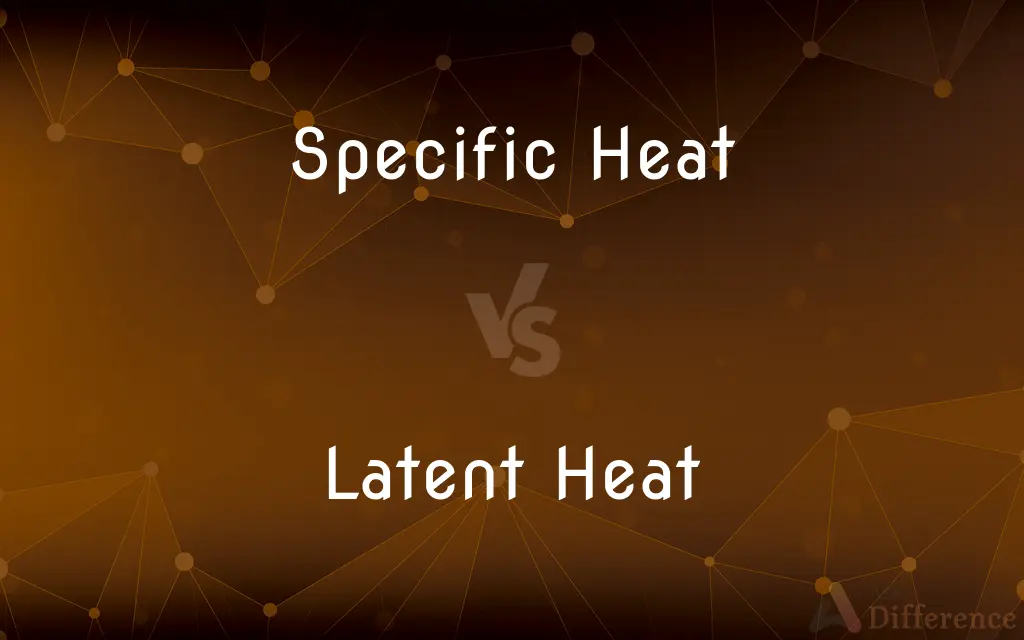Specific Heat vs. Latent Heat — What's the Difference?
By Tayyaba Rehman — Published on October 13, 2023
Specific Heat is the amount of heat per unit mass required to raise the temperature of a substance by one degree Celsius, while Latent Heat is the heat absorbed or released during a phase change without changing temperature.

Difference Between Specific Heat and Latent Heat
Table of Contents
ADVERTISEMENT
Key Differences
Specific Heat is a fundamental concept in thermodynamics and refers to the amount of heat per unit mass required to elevate the temperature of a substance by one degree Celsius or Kelvin. This property is crucial in determining how substances absorb and release heat. In contrast, Latent Heat is associated with the heat absorbed or released by a substance during a phase change, such as melting or boiling, with no change in temperature. It is pivotal in understanding the energy changes during phase transitions.
The measure of Specific Heat is indicative of a substance's ability to store heat and is extensively used to assess the thermal properties of materials. It essentially quantifies how much energy is needed to alter the temperature of a substance. On the other hand, Latent Heat provides insights into the energy required for a substance to change its state, reflecting the intrinsic properties of matter and their interaction with heat without altering the temperature.
In practical applications, Specific Heat is critical in designing thermal systems and materials, influencing how quickly objects heat up or cool down under thermal influence. Conversely, Latent Heat is fundamental in various processes such as refrigeration and climate science, depicting the energy interactions occurring during state changes of substances, without reflecting in the temperature scale.
The variability in Specific Heat among different materials underscores the diverse thermal behaviors exhibited by substances under heat exposure. Distinctly, Latent Heat emphasizes the inherent energy changes occurring within substances undergoing phase transformations, elucidating the concealed heat interactions not evident in temperature shifts.
Comparison Chart
Definition
Amount of heat per unit mass required to raise temperature by one degree
Heat absorbed or released during phase change with no temperature change
ADVERTISEMENT
Temperature Change
Causes a change in temperature
No change in temperature during phase change
Measurement
Measured in J/(kg·K) or cal/(g·°C)
Measured in J/kg or cal/g
Application
Thermal systems, material science
Refrigeration, climate science
Representation
Denotes substance's heat storage ability
Denotes energy change in phase transitions
Compare with Definitions
Specific Heat
Specific Heat is indicative of a substance's ability to store thermal energy.
Due to its high Specific Heat, water can store substantial amounts of thermal energy.
Latent Heat
Latent Heat is crucial for understanding energy changes during phase transformations.
The concept of Latent Heat is pivotal in studying the energy dynamics of atmospheric processes.
Specific Heat
Specific Heat measures how much heat is needed to change the temperature of a substance by one degree.
Metals generally have low Specific Heat, heating up and cooling down quickly.
Latent Heat
Latent Heat represents concealed thermal interactions not observable through temperature shifts.
The absorption of Latent Heat during melting doesn’t result in a rise in temperature.
Specific Heat
Specific Heat is crucial for assessing the thermal properties of materials.
Understanding the Specific Heat of materials is fundamental in thermal system design.
Latent Heat
Latent Heat reflects the amount of energy associated with phase transitions of matter.
During evaporation, substances absorb Latent Heat from the surroundings without getting hotter.
Specific Heat
Specific Heat is the heat capacity per unit mass of a material.
Water has a high Specific Heat, allowing it to regulate temperature well.
Latent Heat
Latent Heat is the energy absorbed or released during a substance's phase change without a temperature change.
The Latent Heat of fusion is the energy required to change a substance from solid to liquid at constant temperature.
Specific Heat
Specific Heat quantifies the thermal behavior of substances.
The Specific Heat of a substance influences its response to thermal exposure.
Latent Heat
Latent Heat is integral to processes like refrigeration.
Latent Heat plays a vital role in the functionality of refrigeration systems.
Common Curiosities
How is Specific Heat different from Latent Heat?
Specific Heat relates to temperature change of a substance with heat addition or removal, whereas Latent Heat relates to phase change with no temperature change.
How is Specific Heat measured?
Specific Heat is measured in joules per kilogram per degree Celsius (J/(kg·C)) or calories per gram per degree Celsius (cal/(g·°C)).
How is Latent Heat quantified?
Latent Heat is quantified in joules per kilogram (J/kg) or calories per gram (cal/g).
Can Specific Heat vary among substances?
Yes, Specific Heat can vary widely among different substances, reflecting their distinct thermal behaviors.
What does Latent Heat refer to?
Latent Heat refers to the heat absorbed or released during a phase change of a substance with no change in temperature.
Is Specific Heat crucial for designing thermal systems?
Yes, understanding Specific Heat is fundamental for designing efficient thermal systems and managing heat transfer.
How does Specific Heat affect water's ability to regulate temperature?
Water's high Specific Heat allows it to absorb and store substantial thermal energy, enabling effective temperature regulation.
Why is Specific Heat important in material science?
Specific Heat is crucial in material science to understand and manipulate the thermal properties of materials.
Does Latent Heat cause a change in temperature?
No, Latent Heat is associated with phase changes of a substance without causing a change in temperature.
Is Latent Heat released or absorbed during condensation?
Latent Heat is released during condensation when a substance changes from a gas to a liquid.
What is Specific Heat in simple terms?
Specific Heat is the amount of heat required to raise the temperature of a unit mass of a substance by one degree Celsius.
Why is Latent Heat significant in climate science?
Latent Heat is significant in climate science to study the energy dynamics related to the phase change of atmospheric components like water vapor.
Is Latent Heat observable through temperature changes?
No, Latent Heat involves energy change during phase transitions without observable changes in temperature.
Does Specific Heat influence how quickly substances heat up or cool down?
Yes, substances with high Specific Heat heat up and cool down slowly, and vice versa for substances with low Specific Heat.
How does Latent Heat impact refrigeration processes?
Latent Heat is vital in refrigeration processes where phase changes occur, impacting the cooling efficiency and energy consumption.
Share Your Discovery

Previous Comparison
Revaluation Account vs. Realisation Account
Next Comparison
Will vs. Will BeAuthor Spotlight
Written by
Tayyaba RehmanTayyaba Rehman is a distinguished writer, currently serving as a primary contributor to askdifference.com. As a researcher in semantics and etymology, Tayyaba's passion for the complexity of languages and their distinctions has found a perfect home on the platform. Tayyaba delves into the intricacies of language, distinguishing between commonly confused words and phrases, thereby providing clarity for readers worldwide.












































